Everyone is talking about Uncle Vanya
Plus, the 411 on a tax-evading art dealer and why Barcelona will be the vacation hotspot of 2026.
Hello again! Thank you for the kind response to my announcement the other day. I had so much fun writing my first official news roundup on Saturday, and I’ve come back to your inbox now to give you plenty of tips to help you sound cultured at your weekday dinner plans, first dates, office happy hours, in those first few minutes of a Zoom call when you’re making small talk and waiting for that last person who needs to be there but “got caught up in another meeting”—so they claim—etc.
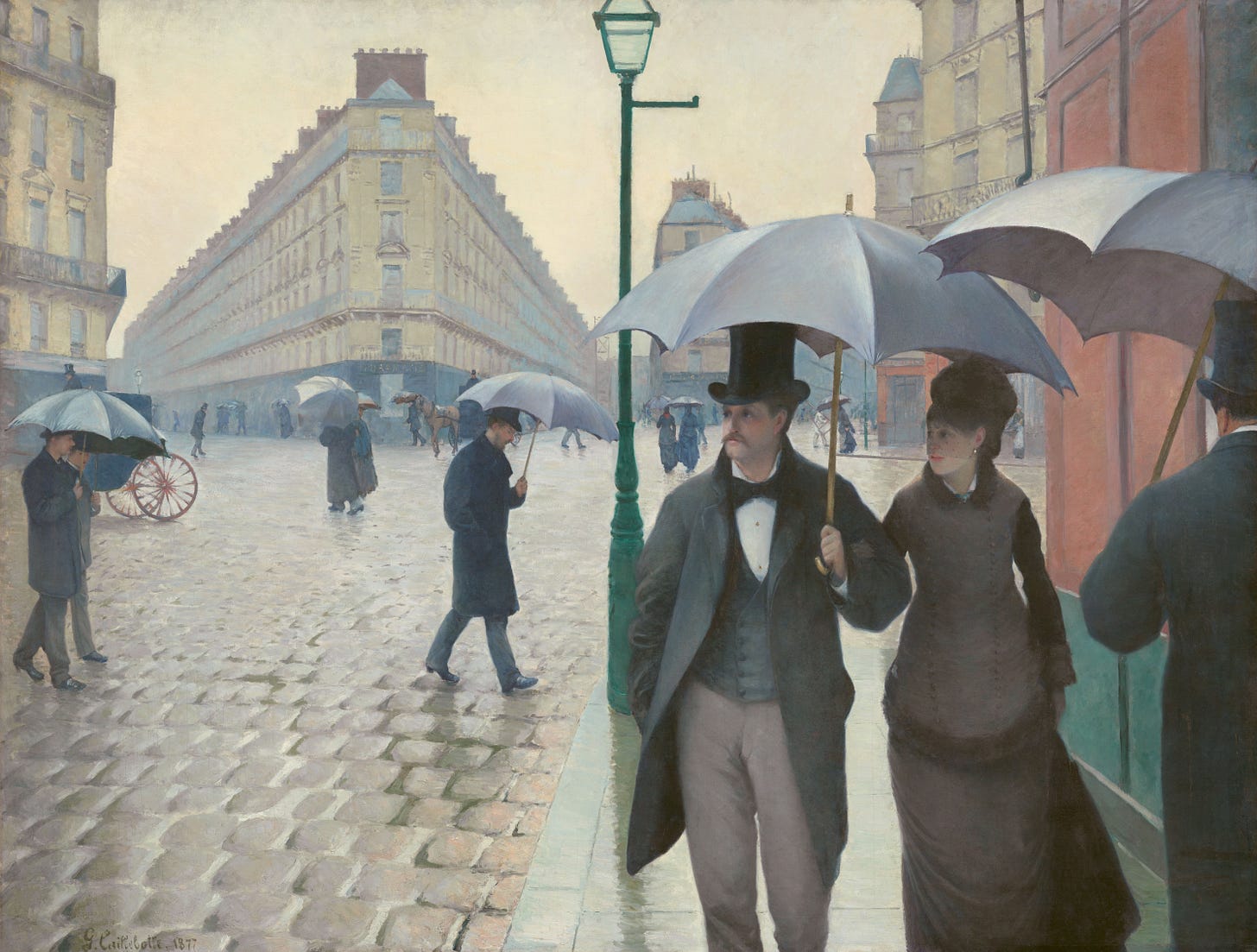
Today we’re getting into the Russian play of the moment, some white-collar crime, and plenty of other fun things.
Break out the samovar. Uncle Vanya is trending. The play, published by Anton Chekhov in 1897 and first produced in 1899, is coming to Lincoln Center Theater this week; its first preview was supposed to open today, but will now open April 3. The show—which stars Steve Carrell (making, somewhat surprisingly, his Broadway debut) as the titular Vanya, William Jackson Harper as doctor and environmentalist Astrov, and Alison Pill as Vanya’s niece, Sonia. Alison is a Tony-nominated actress who you may know from her role as Kim Pine in Scott Pilgrim vs. the World. Alfred Molina—who is in a lot of things, including Boogie Nights, Chocolat, Raiders of the Lost Ark, An Education (a film that was a permanent fixture of my Tumblr feed in 2010), and, of course, Spider-Man 2—is Serabryakov.
Lila Neugebauer, who just got a hefty profile in The New Yorker, directs the play. It should be an interesting production not least because I think Carrell is a phenomenally underrated dramatic actor (see: Beautiful Boy, a not-great movie with great performances); it’s set in the United States in the not-too-distant future, which led playwright Heidi Schreck (who you may know from her one-woman show What the Constitution Means to Me) to eliminate signifiers from the text that might make it feel stuck in its original time and place. You’ll hear no patronymics* or references that would not feasibly be made in 2024. In an LCT blog post, Schreck explains that she and Neugebauer decided that Vanya, of all Chekhov’s plays, felt most “urgent” after the “COVID exhaustion of the past four years.” Lest we forget: Vanya was a pretty key part of the incredible 2021 film Drive My Car (which, if you’ve yet to see it, is worth the three-hour runtime).
Vanya is a straightforward story: a relational drama. It “acknowledges that we’re all sunk in disappointment or fear or depression. It proposes, delicately, that we focus on others, or on the future, as a remedy,” says New Yorker staff writer Helen Shaw in her excellent profile of Neugebauer. That is—I’ll say—a compelling call to action in 2024.
Last week, Andrew Scott—of Fleabag hot priest fame—won a Critics’ Circle Theatre award for his one-man show Vanya, which ran on the West End in the fall (though it received mixed reviews as a concept). Currently going on in London is Orange Tree Theatre’s production of Uncle Vanya, which is adapted and directed by 84-year-old Sir Trevor Nunn, a former artistic director for the Royal Shakespeare Company. Icon behavior! That production runs through April 13. And in California, Berkeley Repertory Theatre will put on its take of the play next February.
In the meantime, “What can we do?” Sonia says to Vanya. “We must live our lives.”
*Here is your easy explainer of Russian patronymics: Basically, it is a person’s middle name, composed of the beginning of their father’s name, plus the appropriate ending—“evich” or “ovich” is the male suffix; “evna” and “ovna” are female. Patronymics are traditionally used in formal settings. I do think it would be incredibly chic to be referred to as Rebecca Chrisevna. Now you can go about with your Dostoevsky or Tolstoy or what have you.
Meet your new favorite art world antihero. Mary Boone is the title of a new Vampire Weekend single and also the name of a notable art gallery owner who, since opening her gallery in 1977, has shown artists such as Ai Weiwei, Jean-Michel Basquiat, Barbara Kruger, and Dan Flavin.
That was before she shuttered her gallery in 2019 because she got caught filing false tax returns. Okay!
Boone owed a cool $3 million in taxes and had written off $1.6 million in personal expenses—including $14,000 at Hermes and $300,000 on beauty expenses—as business-related. When her lawyer suggested Boone’s mental health might be blamed for the tax evasion, the judge, Alvin K. Hellerstein allegedly responded: “What’s the illness that causes people to steal?” Ummm…that is famously kleptomania, your honor.
Of course, she used this sentencing to compare herself to another American icon, as she should. “If I’m going to be the Martha Stewart of the art world, I would hope to do it with the same humility, humor, grace, and intelligence that she did,” she told ArtNews in 2019. “I’m trying to be optimistic and see this as a learning experience.”
She was sentenced to 30 months, but only served 13, getting released early after her federal correctional institution in Danbury, Connecticut, saw an uptick in COVID cases in June 2020.
Anyway, Vampire Weekend didn’t get her permission or give her a heads-up that they were using her name as a song title, but she’s cool with it. Artnet gave her a ring to get her take, and apparently, her son had informed her about the song. “Why did they do that? Does this mean I’m a vampire?” she said.
Alicia Keys and Swizz Beats (Kasseem Dean) are casually putting together one of the greatest contemporary art collections. And I had no idea! That is, until I went to their exhibit at the Brooklyn Museum. Giants: Art from the Dean Collection of Swizz Beatz and Alicia Keys runs through July 7 and features art from greats such as Kehinde Wiley, Mickalene Thomas, Lynette Yiadom-Boakye, Lorna Simpson, Nick Cave (the artist, not the musician), and more. In total, the exhibit features more than 100 works by Black artists.
In a 2019 interview with T magazine, Dean explains how he got into collecting—using the money from his first hit with DMX in the ’90s to buy an Ansel Adams photograph. Since then, Dean and Keys have grown what the magazine calls “one of the great American collections of contemporary art.”
The exhibit emphasizes how strongly the couple feels about the importance of supporting artists—especially Black artists—as creatives themselves. Dean has a really interesting perspective on the art industry, too, as a music producer. While he’s never sold pieces from his collection (only traded), he’s been an advocate for artists to receive royalties when their art is resold; after all, he’s greatly benefitted from royalties in his own career. That advocacy inspired collector Joel Straus, when selling a Kerry James Marshall artwork for $1.8 million in 2018, to announce that he’d be giving Marshall a percentage—which T notes was most likely the first time a living artist received a cut thanks to a Sotheby’s sale of their work.
And Dean is conscious of the impact his actions have on the surrounding industry. “One of his tactics…is walking into a gallery to ask questions about one of their younger artists—often an artist of color—who maybe hasn’t had a show in a while, and if the gallery seems unenthusiastic and tries to sell him work by a different artist, he keeps pushing for the original artist he came to see, who often winds up getting a solo show as a result of his inquiries because he’s shown the artist has market value,” M.H. Miller writes for T. “…His goal has been nothing less than to ‘change the climate’ of the art world, to shift the color of the artists on the walls of galleries and museums, which for most of history have been reserved for white men.”
This is what a true patron of the arts looks like!
Inspiration for all the procrastinators out there: The famously under-construction Sagrada Familia, Antoni Gaudí’s basilica in Barcelona which began construction in 1882, will finally be finished in 2026. Well almost. The building itself will be finished then, but it will take until 2034 for a controversial stairway, which will lead to the structure’s main entrance, to be finished. That is, if it is ultimately approved.
Why is the stairway so controversial? First of all, there’s debate about whether the 60-meter (nearly 200-foot) stairway was part of Gaudí’s original plan, or whether it was dreamed up by his disciples (and therefore not protected by Unesco). Much more important is the fact that the plans for the stairway would involve the demolition of multiple buildings, which could evict 3,000 people. That certainly does not seem like something Jesus would do!
In any case, the building is a big draw for tourism. In 2023, it saw 4.7 million visitors—nearly its pre-pandemic levels—with 85% of those tourists coming from outside of Spain.
And Sagrada Familia doesn’t even come close to breaking the record for longest construction time. That goes to Germany’s Cologne Cathedral, which took a neat 632 years. And Notre Dame in Paris took 182 years (ICYMI, that church just revealed its newly rebuilt spire in February, and it is on track to reopen in December).
The passing of a pioneer. Lorraine Graves, a former principal dancer with Dance Theater of Harlem passed away on March 21 at the age of 66. She joined the company in 1978, just nine years after its founding in 1969 by New York City Ballet principal Arthur Mitchell and ballet master Karel Shook. Graves starred in many Dance Theater of Harlem productions; one notable role was Myrtha, queen of the Willis (vengeful spirits of women who died of broken hearts, who make their scorned lovers dance to their own deaths) in the company’s production Giselle, which set the classical ballet in Louisiana.
Graves wanted to become a ballet dancer after watching NYCB’s Nutcracker on television as a child, and she spoke about how Dance Theater of Harlem provided a space and stage for Black dancers in a world that has historically been (and still largely is) exclusionary of dancers of color.
Celebrating its 55th anniversary, Dance Theater of Harlem opens its 2024 season starting April 11 at New York City Center. And if you want to learn more about the company’s history, you’re in luck: Writer Karen Valby’s book The Swans of Harlem: Five Black Ballerinas, Fifty Years of Sisterhood, and Their Reclamation of a Groundbreaking History comes out April 30. The book profiles prima ballerina Lydia Abarca alongside four other founding and first-gen company members of Dance Theater of Harlem.
Congrats to this man. Dr. Wayne Modest, professor of material culture and critical heritage studies at Vrije Universiteit (VU) Amsterdam and director of content at Wereldmuseum, the National Museum of World Cultures in the Netherlands, is being honored this week at Bard College’s 27th Annual Iris Foundation Awards. The awards recognize “scholars, patrons, and professionals who have made outstanding contributions to the fields of decorative arts, design history, and material culture.”
Dr. Modest’s work examines the role of the museum and how we frame material culture. In this video interview from 2019, he unpacks ethnographic (world culture) museums and how they are a part of the “entanglements of colonialism.” What might it look like to undo colonial structures within the museum? To reimagine the perspective from which history is told? Ultimately, he maintains that a museum should be a place for discussion and debate, not just exhibitions—conversation, after all, is a critical process for learning, growing, and drafting better futures based on our past. A good reminder!
In defense of hedonism. I am excited to pick up a copy of Becca Rothfeld’s All Things Are Too Small: Essays in Praise of Excess, which comes out today. I have heard great things from my friend Ama who read a galley copy. I do feel like we are in an era of aesthetic Calvinism (I swear to god if I see another Blank Street Coffee I am going to scream) so this book feels right up my alley. If only I could read it while wearing the hedonism sweatshirt from Ashish’s fall 2018 ready-to-wear collection.
We are entering the era of “rigor.” No more feigned effortlessness!
Ok bye! ▲




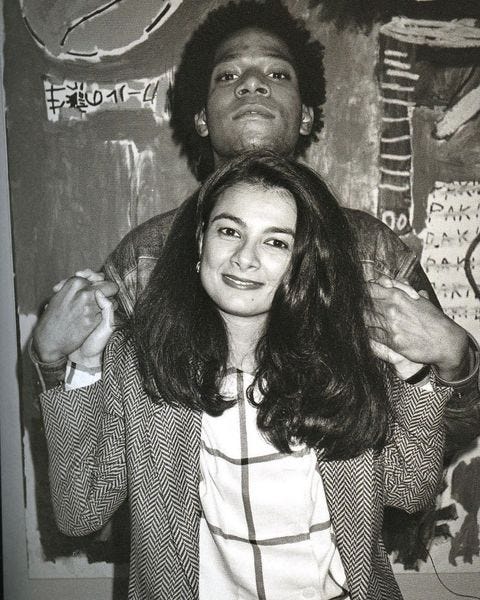
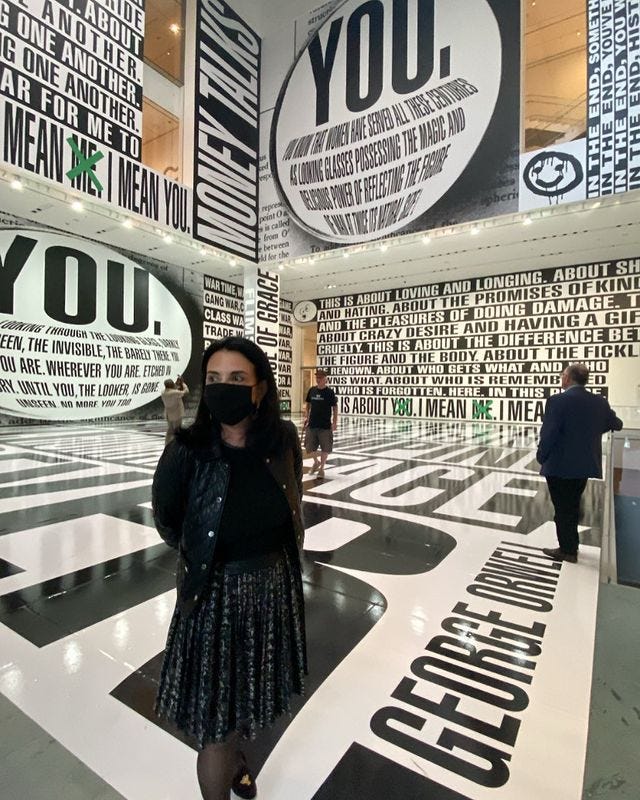

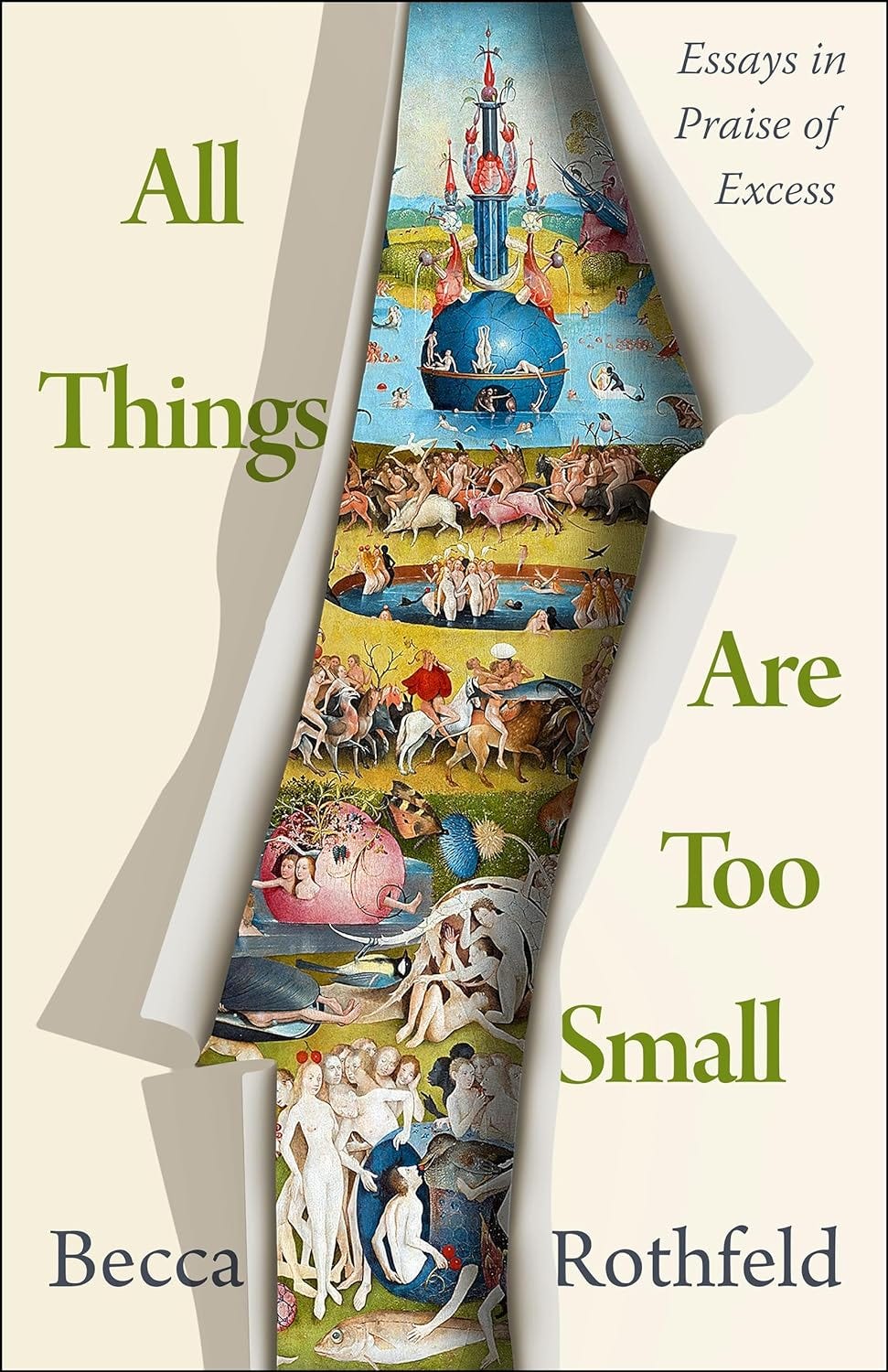
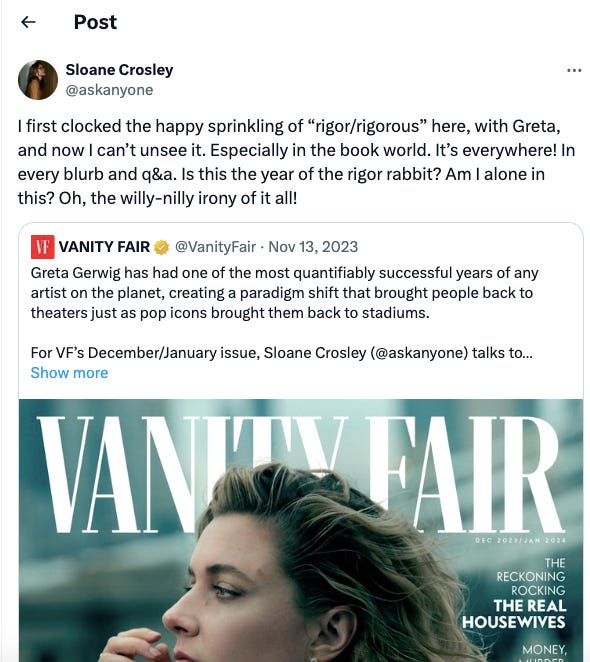
Recently discovered your newsletter and loving the curated tidbits of cultural news! Keep them coming 🫶